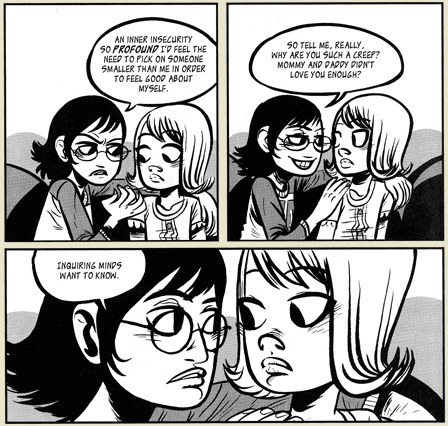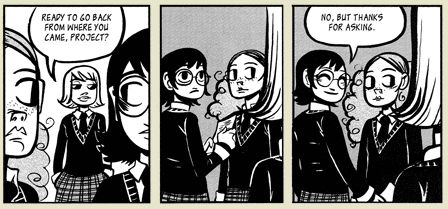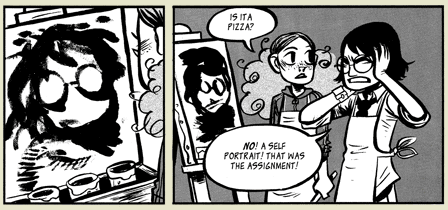The War at Ellsmere
If young adult fiction suffers from one thorn in its literary side, it's disposability. Books in the demographic are devoured and forgotten with an ease that must wound all but the most circumspect authors. Works directed at the youthful stock and trade so heavily on tropes that they have passed from the realm of cliche into something ritual, a liturgy of familiarities. It makes sense, really. These are books aimed at a people who, by the laws that govern universal process, have only the barest experience of the world we all inhabit. Authors aiming to interest nascent adults need drum up narrative conflicts with which these readers will be acquainted—and let's be honest, the well of experienced conflicts will run a lot deeper for grown-ups than it will for nearly any fourteen-year-old.
It's not so much that teenagers are shallow (though many are), but their depth of experience certainly is. While I could have read and understood Franny & Zooey or Savage Detectives or The Long Goodbye as a freshman in high school, they certainly wouldn't have resonated with me in nearly so substantial a way as they did twenty years later. So those hoping to sell books to young audiences have a slender few options to choose from and the end result is a lot of books that are enjoyable enough but are generally just variations on a theme. Young adult literature is often therefore forgettable, disposable. It's not the stories that matter so much as the cheap thrill of the moment's entertainment. And this is even true of many wonderful examples of the demographic. It's true of The War at Ellsmere.

Between finishing The War at Ellsmere and beginning this review, I also read Raina Telgameier's Smile and a couple volumes of Kaoru Mori's A Bride's Story. By the time I sat down to write, I could remember very little of what occurred in The War at Ellsmere. Here's what stuck: That it's a boarding school drama—girls' boarding school. That it's a typical outsider heroine-goes-up-against-the-queen-bee–type story. That it was enjoyable enough that I could swallow it whole over a lunch break. That I didn't regret reading it. And that I am now a lifetime fan of Erin Faith Hicks' art.
She's amazing. Her art resembles roughly what you'd find in a volume of Scott Pilgrim—only with a touch more detail and (probably) a touch more heart. Hicks' characters are built of expressions and she sells these effortlessly, taking a character through a range of visible, discernible emotions across the space of a single page. She doesn't restrict herself to a particular grid-size and while not as free from the chains of the panel as, say, your average manga, she still uses up her paneling space in creative ways that further work to buy the reader in to her narrative tricks and treats.

I mentioned above the few things I'd remembered about the book and really, there's hardly anything more that one needs in order to understand The War at Ellsmere. It leverages common tropes enjoyably and employs some rad art. Still, in the interest of padding better informing the potential consumer, I glanced through the book again to jog the memory of it.
Jun (Juniper to strangers) is a new arrival at hallowed old Ellsmere, a girls' school with a certain longevity built on the instruction of alumnists' daughters—and the occasional charity case. Jun is one of those scholarship students, the one poor girl in a menagerie of the wealthy. She (of course) catches the evil eye of a girl who is never really stated to be the most popular, though at least as concerns Jun's story, the girl is far-away the most powerful. Jun enjoys their antagonistic relationship until the moment, as on might predict, she doesn't. And it goes from there.

In some ways it's all very obvious and predictable and really exactly what we expect. But in the end, that doesn't matter so much. The War at Ellsmere's pretty much what it has to be, so we read and are aware of where it must go and what it must do to get there. But all the same, there's something special in the heart of the book. Hicks' art breathes life into characters who might otherwise remain hollow YA archetypes. Through her steady hand, we come to like and appreciate these characters and it's in their quiet, reflective moments that Hicks allows them to at least begin to transcend their form. They never do quite escape their destiny—a fate commanded by demographic—but it's an admirable attempt and I was happy to be there for it.
Good Ok Bad features reviews of comics, graphic novels, manga, et cetera using a rare and auspicious three-star rating system. Point systems are notoriously fiddly, so here it's been pared down to three simple possibilities:
3 Stars = Good
2 Stars = Ok
1 Star = Bad
I am Seth T. Hahne and these are my reviews.
Browse Reviews By
Other Features
- Best Books of the Year:
- Top 50 of 2024
- Top 50 of 2023
- Top 100 of 2020-22
- Top 75 of 2019
- Top 50 of 2018
- Top 75 of 2017
- Top 75 of 2016
- Top 75 of 2015
- Top 75 of 2014
- Top 35 of 2013
- Top 25 of 2012
- Top 10 of 2011
- Popular Sections:
- All-Time Top 500
- All the Boardgames I've Played
- All the Anime Series I've Seen
- All the Animated Films I've Seen
- Top 75 by Female Creators
- Kids Recommendations
- What I Read: A Reading Log
- Other Features:
- Bookclub Study Guides











